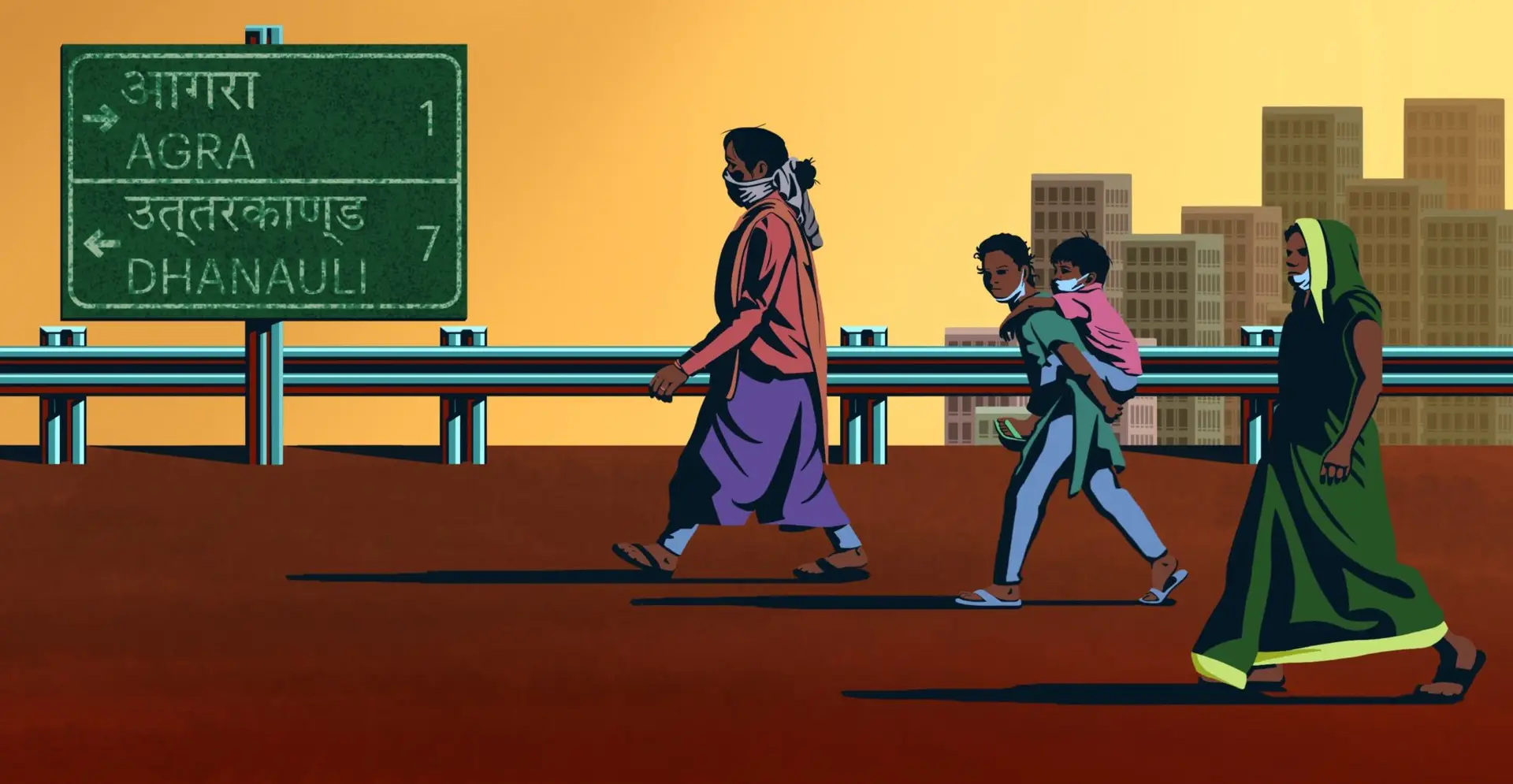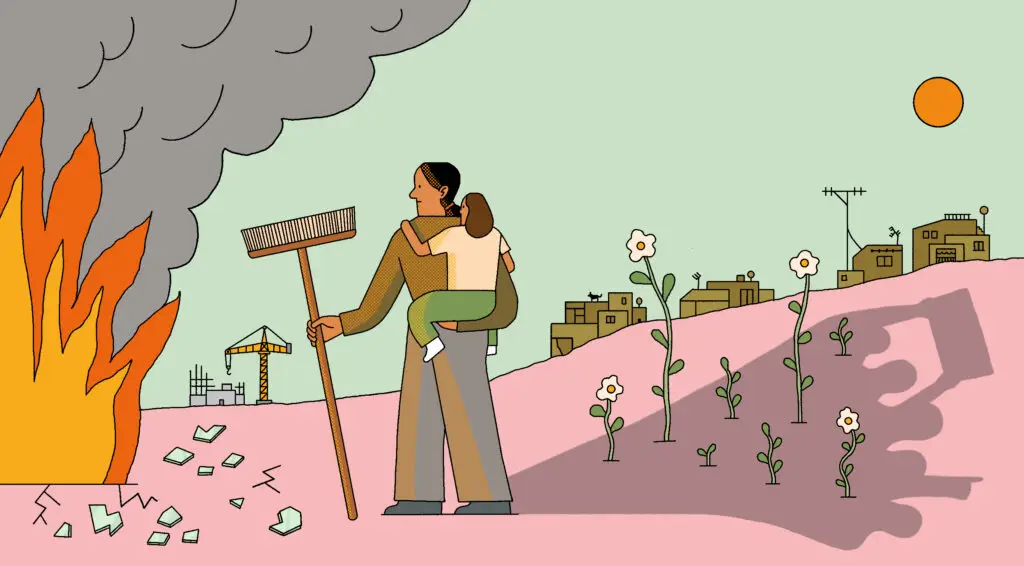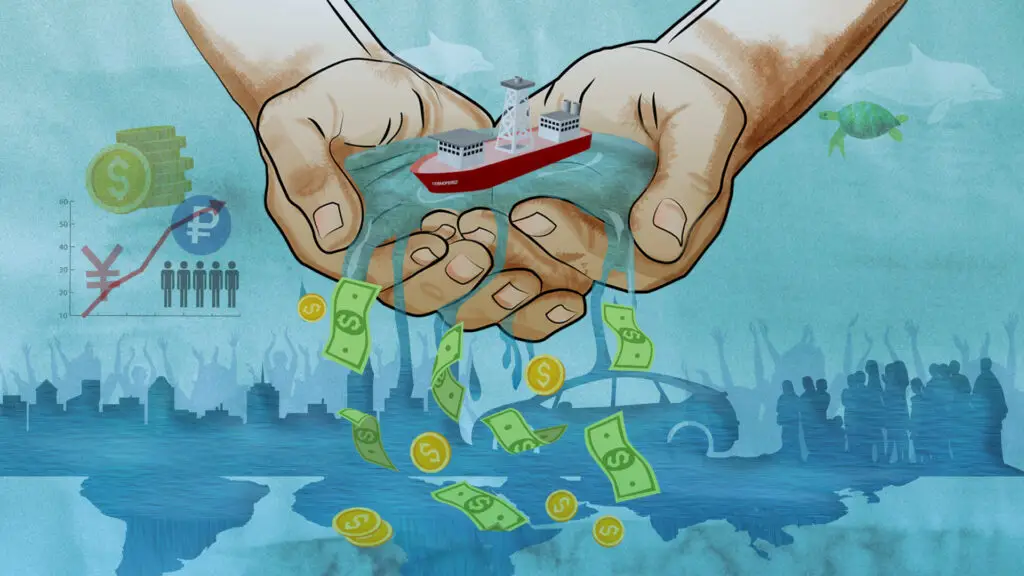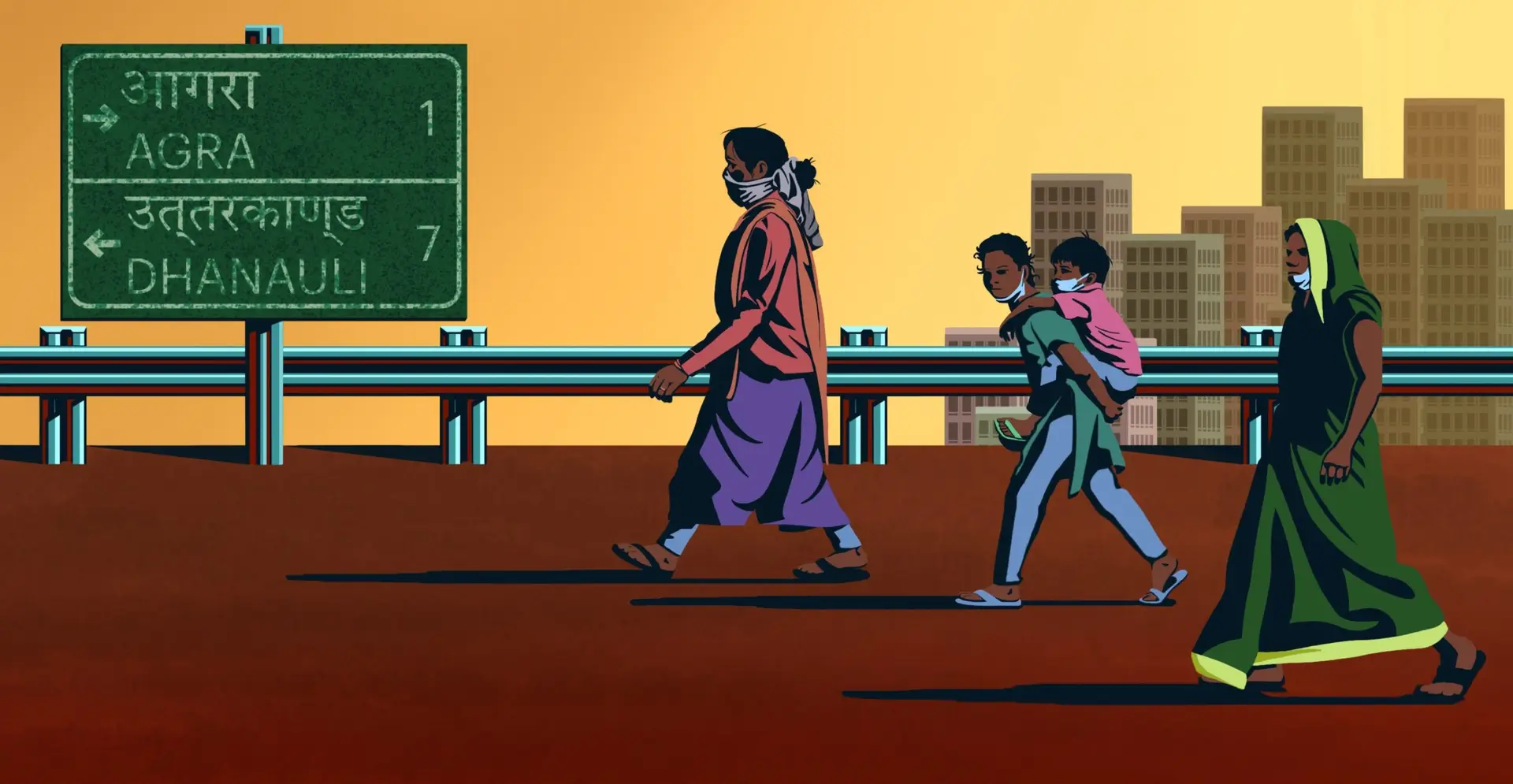
Staying Behind: Out of cities and work, India’s women migrant workers struggle to rebuild their lives
- Written by Anuja
- Edited by Tina Lee
- Illustration by Walker Gawande
India’s Covid-19 lockdown sent millions of internal migrants back to their homes across the country. But when restrictions lifted, many women stayed behind and lost work, compounding layers of inequality.
Sunita Devi’s life is a study in contrasts. On a cold February morning, the 35-year-old daily wage worker turned the wheels of a chaff cutter in her village in Uttar Pradesh, India’s most populous state. If ‘things had not changed’, Devi would have been 400 kilometers away quarrying stones instead in the neighboring state of Rajasthan.
For more than 15 years now, Devi and her family have been inter-state migrants who travel to more than half a dozen cities from Mandi Mirza Khan village in search of work. Her migration, like most of India’s informal workforce, is seasonal and often circular (to earn and remit money back), lasting anywhere between six to ten months in a year. She has led a hardscrabble life of manual labour to earn just 9,000 rupees or INR (roughly 110€) a month.
But everything changed in March, 2020, when India announced a stringent nationwide pandemic lockdown, with just four hours’ notice. She was among the millions of other migrants who returned to their villages, many on foot, as the rest of the country secured themselves safely indoors.
The experience crushed her. Two deadly waves of the pandemic and a series of smaller lockdowns by state governments followed until last year. Months of uncertainty meant that the highly mobile population of migrant workers, particularly women, were worst impacted. The period saw more women than men lose jobs.
Devi’s husband Man Singh has returned to the migration cycle, except for a brief pause. However, she decided to stay behind in the village to take care of their four children alone. Earlier, her children traveled with her each time she migrated. She currently has no child care support at home from relatives or extended family. Her reasons for not migrating again were to cut down on travel and housing expenses, safeguard her children from getting exposed to the virus and the lack of confidence about how much work she would find in the cities.
“From breaking stones to cutting grass fodder, that is how much my life changed in two years,” she said as her husband looked on.
“I have tried finding work in the village. I took up odd jobs like labouring on other people’s farm but it pays pittance. Honestly, I am simply wasting my time and effort,” Devi said. She manages to find work for five or six days in a month, through which she earns roughly 1,200 INR (15€) monthly.
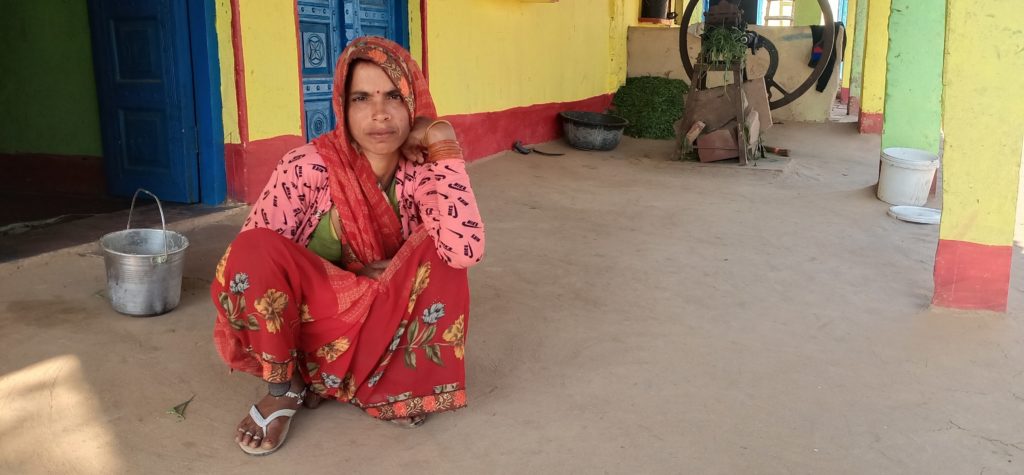
Layered vulnerability
Devi is not alone. Just across the road to her are women like Neetu (goes by one name), a construction worker who used to travel more than 1600 kilometers to coastal Vijaywada city in India’s southern state of Andhra Pradesh and Guddi Devi, who was a daily wage worker and earlier travelled to Rajasthan alone for work. Similar stories of distress were recounted by women from Rajasthan, West Bengal and Odisha.
These women have known no other way of earning livelihood than migrating to look for work but they have now chosen to stay behind.
They migrate because employment opportunities in the rural areas are limited to agriculture or allied activities while cities offer jobs in different sectors including manufacturing, infrastructure creation and domestic work. The inequality between Indian states or the gap between the rich and poor states is large and has increased considerably over time.
Experts like Benoy Peter, the executive director of Indian think tank Centre for Migration and Inclusive Development (CMID) said that there is a “layered vulnerability” for women when they stay back to survive during a crisis.
There are a significant number of families which otherwise used to migrate pre-pandemic but have now remained at native places. With women specially, the staying back has impacted not just their mobility but also their autonomy.
Benoy Peter
An unprecedented crisis
In the summer of 2020, more than 11.4 million workers returned home as several families covered hundreds of kilometres on foot. Such a scale of internal exodus was ‘visually perceived’ only after India’s partition in 1947.
Over the last two years, migrant worker families have witnessed wage loss, piling of debt and continuing uncertainty over jobs recovery. A report by the International Labour Organisation in December 2020 warned that the pandemic was “likely to push many more millions of rural households deeper into poverty and debt traps” in India.
More than 90% of India’s workforce is estimated to be informal or unorganised and consists predominantly of migrant workers. They are considered to be key drivers of India’s economic growth.
According to estimates, India has 600 million internal migrants, out of which half are women. Out of this, 140 million are estimated to be migrant workers.
Gender is a key distinguishing factor. More women than men among migrant workers are affected due to the protracted impact of the Covid-19 pandemic because it has worsened already pre-existing vulnerabilities like high gender pay gap, increased care work and gender discrimination at work. It lowered their income due to overall job losses and forced them to take up jobs that paid less. They have coped in different ways. While some opted for short distance and short-term migration, others decided to stay behind to cut down on expenses.
Asha Hans, director of director of Development Research Institute (DRI) in Odisha’s capital, Bhubaneswar, who has extensively worked on issues of women migrant workers said that during the pandemic they faced loss of personal assets by selling or pawning whatever family gold or valuables they had to make sure that the male members could travel for work.
“To migrate you need money. Many male workers went back immediately while several women stayed back. In some cases, migrant families back home had very small pieces of land but they could no longer employ farm labourers and so women chose to stay behind to take care of it.”
Asha Hans
Like Hans mentioned, women migrant workers in some cases have also stayed behind to take care of their family’s agriculture related work.
Patterns of seasonal migration in India are also often linked with the agricultural cycle when families prefer being back in the village or working in urban centres like construction, which peaks before or after the monsoon season. Such families do not permanently settle in the urban spaces due to lack of resources, high cost of living, poor housing conditions or rare job opportunities.
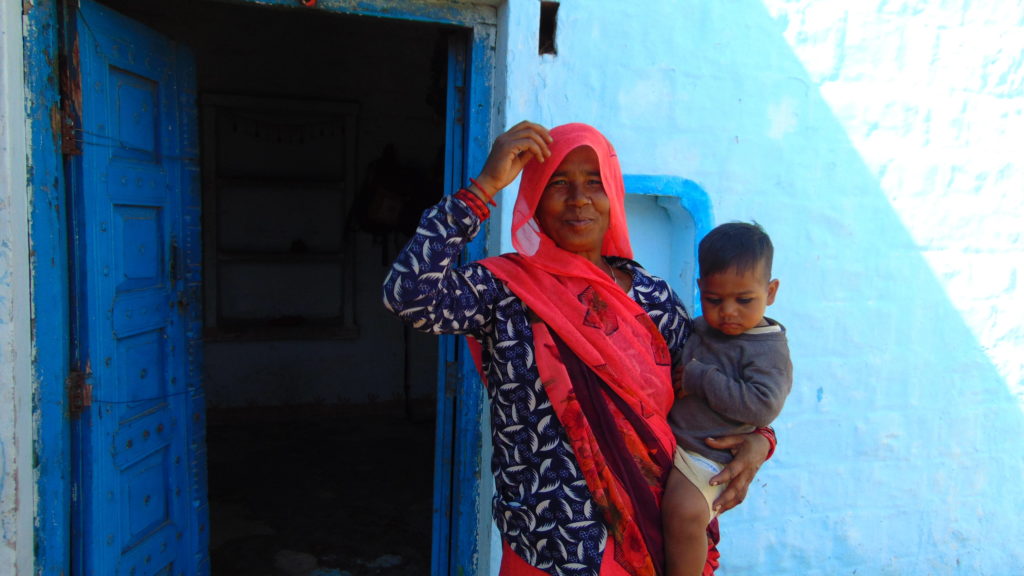
Staying behind
While there is no official data on how many woman have stayed behind, a survey published last year by Yale University tracked a group of around 5,000 migrants who returned to their home villages in 2020. A year later it found out, that ‘only 47% of women had re-migrated, in contrast to 55% of men’, that too amidst a stark gender unemployment gap.
The crisis is grimmer in the case of single female migrants — those who travel without male family members — and have now fallen out of the workforce. Sairul Begum, 29, lives in Dhanauli, a village on the outskirts of Agra, less than ten kilometres away from the Taj Mahal. She is a skilled embroiderer who stepped out of her state for the first time in 2018. She travelled with a group of women to city of Rourkela, famous for production of steel, in Odisha through a train journey of 26 hours covering almost 1200 kilometres.
There, she earned a monthly income of 100€ but her travel, accommodation and living expenses were by the employers, which meant she could send money back home. Ever since she returned home in early 2020, her employers have not called her back, citing lack of resources.
She said her earnings helped her contribute to the family’s expenses but since she returned, she relies entirely on her husband. Of all things that she misses, it is the financial independence the most. “After staying behind for such a long time, I am not sure if I will be able to go back,” she said.
Loss of identity
Archana Roy, who teaches at the Department of Migration and Urban Studies in Mumbai based International Institute for Population Sciences (IIPS), said that when women migrate for work to urban areas, they have the identity of a ‘worker’.
Returning home or staying back means that their responsibility of both bread winning and care giving increases. Unlike men, they face an immediate loss of network and it leads to issues like poor wage negotiation, increased working hours and higher chances of exploitation.
Archana Roy
Migrant worker families in informal sector often live with other related precarities like lack of social security protection and access to basic services. However, issues of job loss and wage reduction have immediate impact on their lives. In most cases, it is the only option that families have to improving their lives due to lack of opportunities in the source villages they come from.
Women and re-migration
While, the issue of re-migration of women workers is pronounced in a state like Uttar Pradesh, which has India’s highest outmigration numbers, surveys indicate that similar trends could be visible in other states too.
A 2021 study in eastern states Bihar and Jharkhand showed that post-pandemic, the intent to re-migrate was lower among women workers (17%) than their male counterparts (37%). It added that most women who lost their jobs dropped out of the labour force and ‘are neither looking for jobs nor thinking of migrating.’
Bhaskar Chakarvorty, an economist at Warwick University and was a co-author of the survey, said that its findings indicated that ‘remigration and reemployment’ of women migrant workers was a critical issue.
“This could be widespread and be applied to large sections of rural, semi-skilled women. This might have implications of future labour market prospects as it may be difficult to bring them back to work once again,” he said.
Intergenerational debt
Women workers make particularly tough choice to stay behind if the family has taken loans or if they fall under the category of ‘debt-migrants’. Simply put, these are workers who agree to migrate for work in exchange of being paid an advance wage in the form of debt.
In some of the worst cases, the piling amounts lead to intergenerational debt traps forcing acute distress migration.
Purnima Barge, a 35-year-old brick kiln worker from a village near Balangir in Odisha, a state in India’s east on the Bay of Bengal, had to make a similarly difficult choice last year. For a decade now, she and her husband, Jaidhar Barge along with their three children used to migrate to different cities in the Southern Indian states of Andhra Pradesh and Telangana for work on advance wages that were later paid off as debt.
“Recently, I have had some health issues and I am not able to work well. I had no option but to stay back with my children while my husband has continued to go. There was a learning facility in the brick kiln for my children but back here I have not been able to put them in a school,” Barge said over the phone as translated by Dayasagar Pradhan, a safe migration activist in the region.
She added that her family took informal loans from an acquaintance last year to the tune of 400€. She feels in the absence of her not working due to lack of opportunities in the village, her husband will take more than a year to repay it. She will try to re-join him for work later this year.
Policy intervention
Weeks after the migrant workers crisis of 2020, both the union and state governments sprang into action, announcing a series of steps like free foodgrain, portable ration cards, affordable rental housing and skill training among others.
To focus its attention on job generation in rural areas, the union government in the same year launched an employment and rural public works scheme focused on boosting employment and livelihoods opportunities in 6 high out-migration states. The Indian government’s public policy think tank NITI Ayog is also drafting a national policy on migrant workers in consultation with stakeholders including rights groups.
Amidst this, India also kicked off a national database to count and keep track of its unorganised and migrant workforce. Till the end of February, a majority of 52.7% workers registered on the portal are women, indicating the need for specific policies for their welfare. Given the protracted impact of the Covid-19 pandemic, experts say there is a growing need to have a gender sensitive migration policy with special attention towards women who have fallen out of the workforce in the last two years.
Sona Mitra, principal economist at the New Delhi based Initiative for What Works to Advance Women and Girls in the Economy (IWWAGE), said that focus should be on creating a robust social security net and steady employment.
“There also needs to be proper infrastructure particularly transport mobility so in case there is an emergency, they can return home safely,” she said.
Long term impact needs long term attention
The immediate impact of the Covid-19 pandemic and its resultant movement restrictions is evident given the widespread job losses among informal workers, particularly women. While there were early signs of recovery last year, the crisis is far from over.
Most experts were unanimous in saying that in the absence of any large-scale data or surveys, it was difficult to assess what could be its long-term impacts on women migrant workers. But almost all the women migrant workers quoted above said that their issues need more long-term and consistent help from policy makers to recover from the impact.
Most of them, including Sunita Devi, also said that if given a chance, they would like to go back to the migrating again and earn a steady livelihood for themselves and their children. But for now, she and others continue to remain cautious. “Not at least this year,” she announces at the end of the conversation.
This article was produced as part of DW Akademie’s Media Fellowship on Displacement and Migration.
Related Posts

Capulálpam de Méndez: A struggle for land and memory
After a Canadian mining company challenged a Zapotec community’s Indigenous identity, recalling the ancestral names of sacred landmarks helped reinvigorate their connection to the land – and defend it from extractive industries.
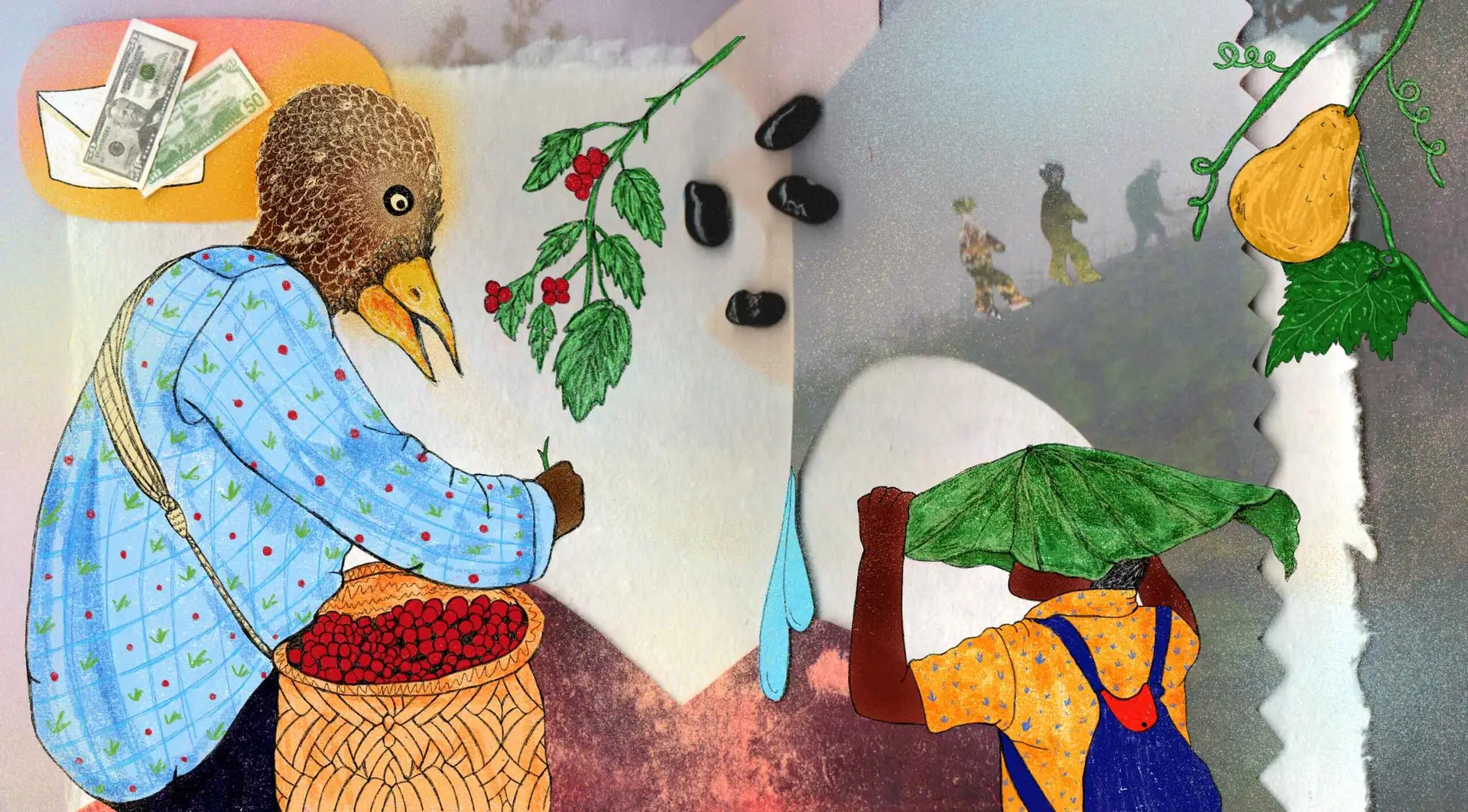
San Pedro Sochiapam: First the birdsong, then the whistles
In a remote community enveloped in cloudforest, a whistled form of the Indigenous Chinantec language is perfectly adapted to the land and its weather. But who needs whistles when you can use WhatsApp?
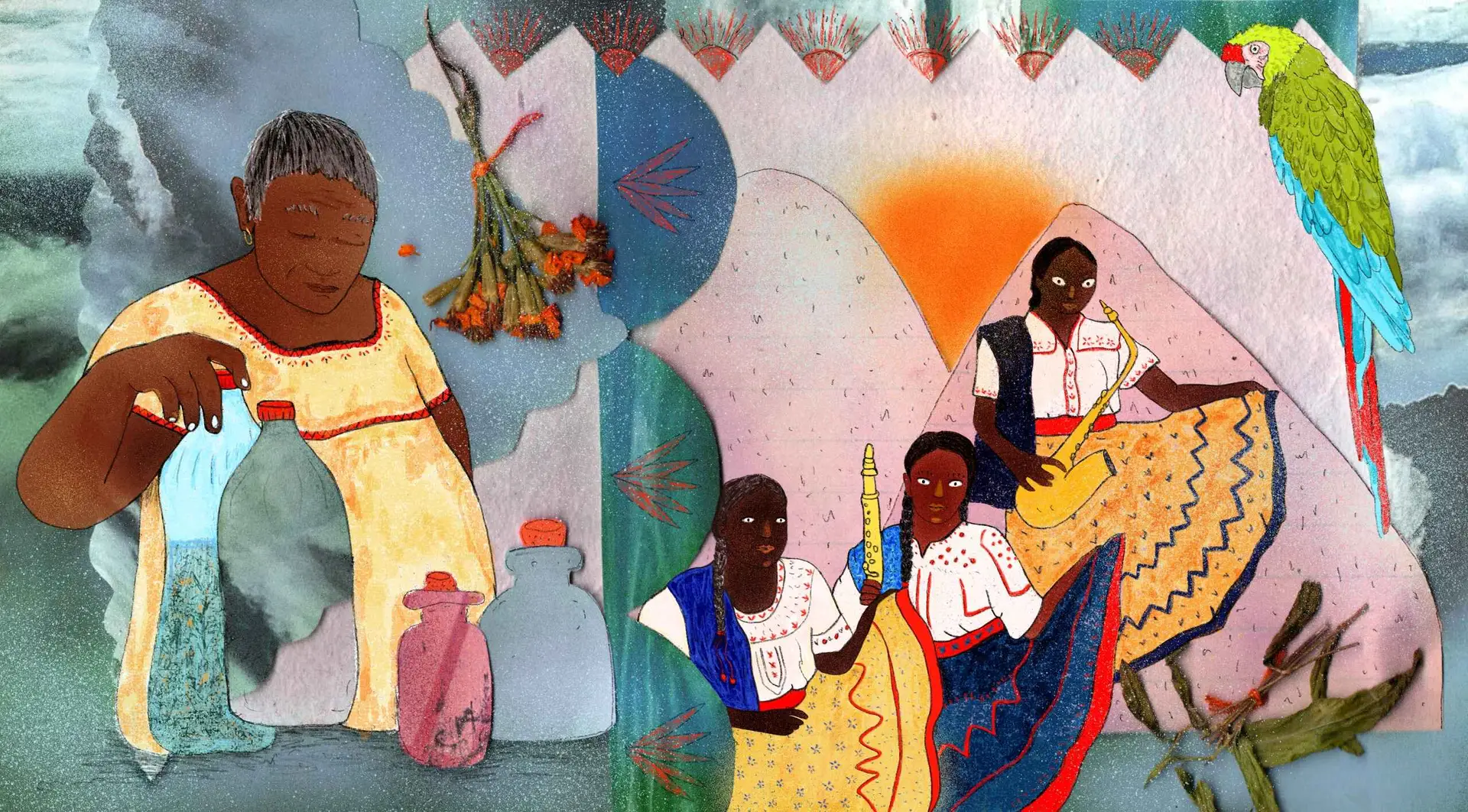
Sierra Mixe: A conversation with Mother Nature
Medicinal wisdom is embedded in Indigenous Mixe languages. By sustaining their mother tongue and practices involving herbs and healing rituals, Mixe people keep alive a cosmovision in which they speak to Mother Earth.
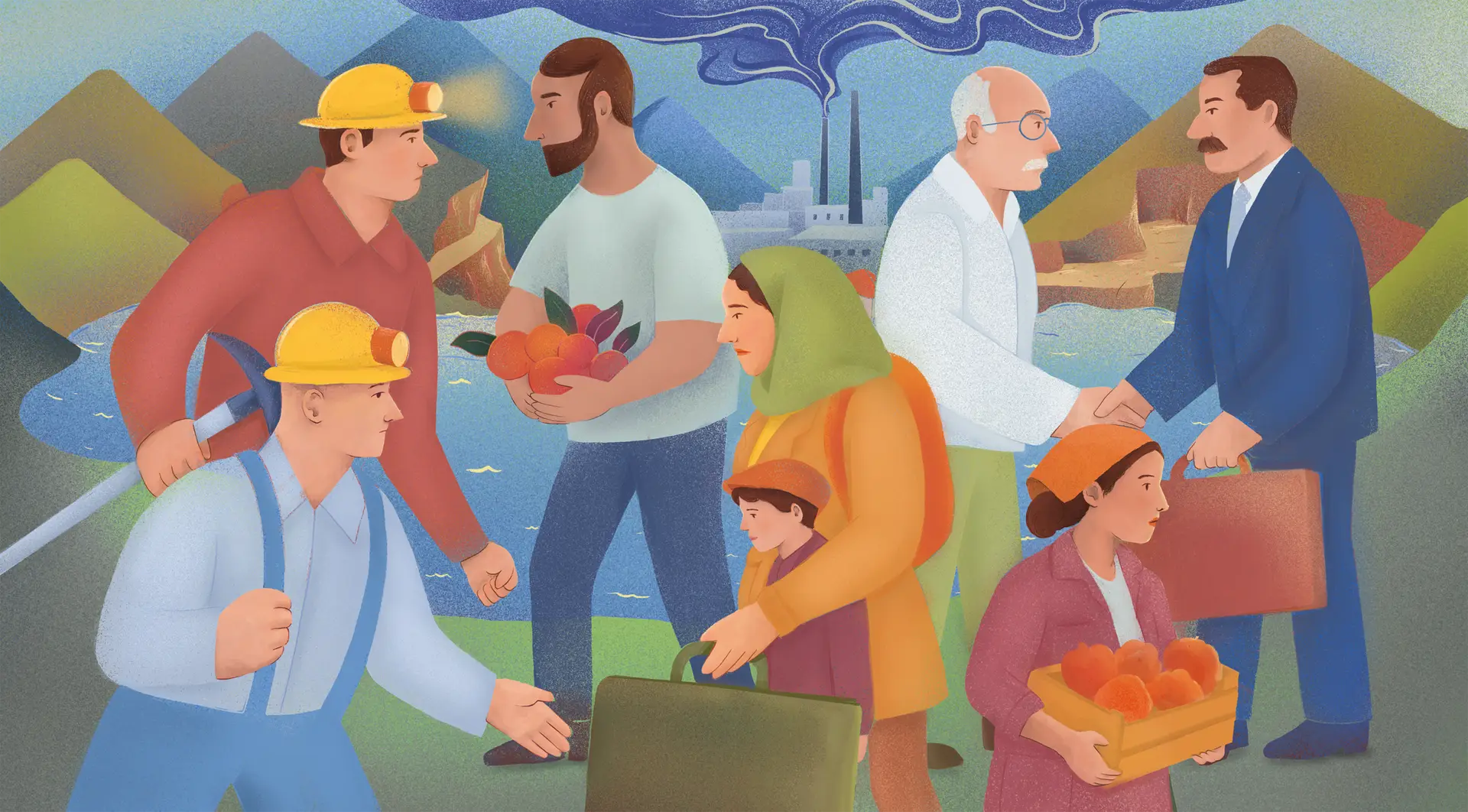
Foreign capital, local burden: Who benefits from mining in Bosnia?
When foreign companies restarted mining operations that had been shuttered since the breakup of Yugoslavia, Vareš had high hopes of economic revival. But as the state fails to take a stand against pollution and deforestation, optimism has given way to nostalgia for the socially owned mines of the communist era.
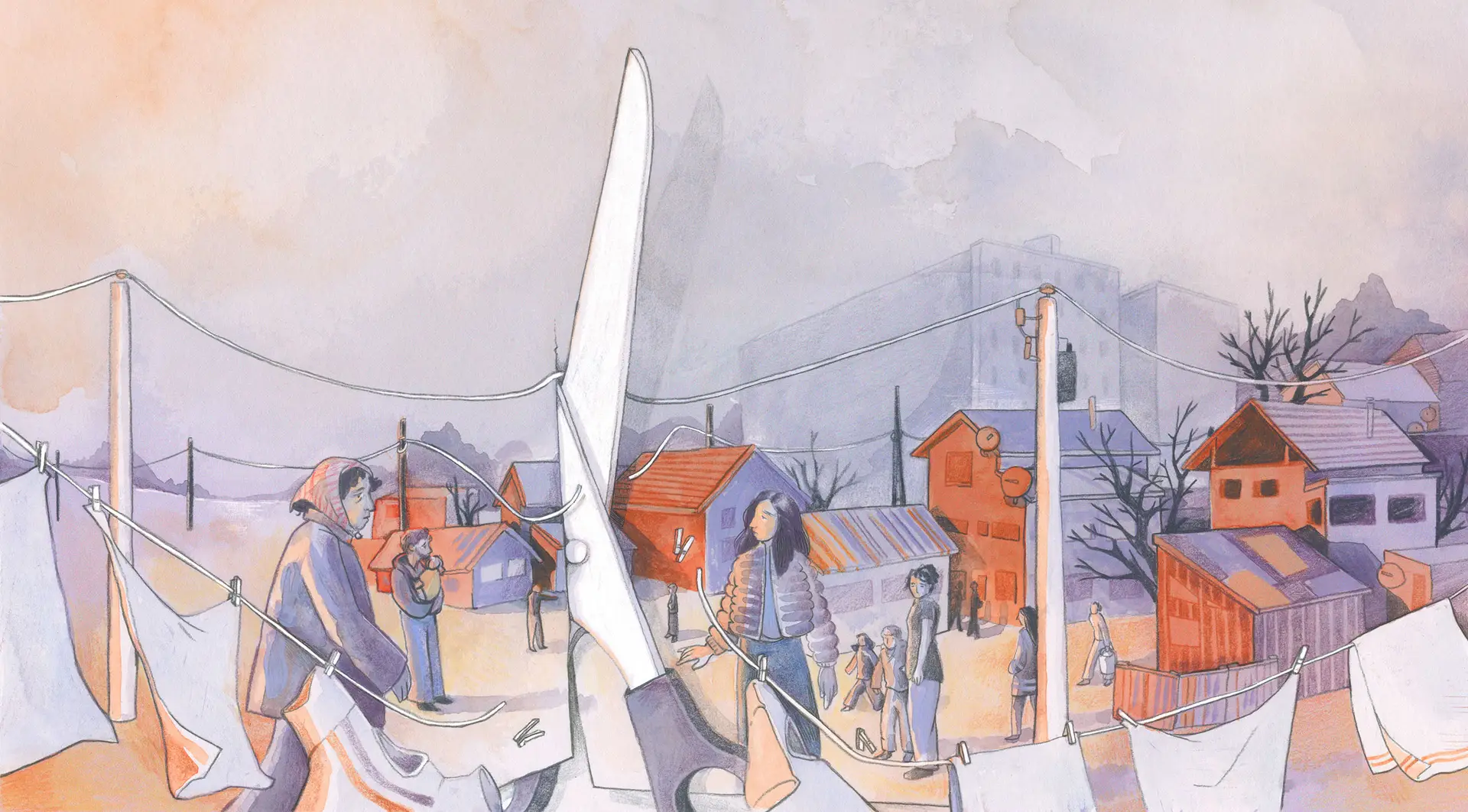
“We can only get out of here if we die”: How EU funds to help Roma communities are reinforcing isolation, prejudice and exclusion
Roma people are routinely excluded from jobs, housing and public services. Yet tens of billions of euros to promote Roma inclusion are vanishing into projects with no transparency or measurable impacts. Our investigation found evidence of some of this EU money being spent on displacing or demonizing Roma communities in Hungary, Bulgaria, Czechia and Italy.

